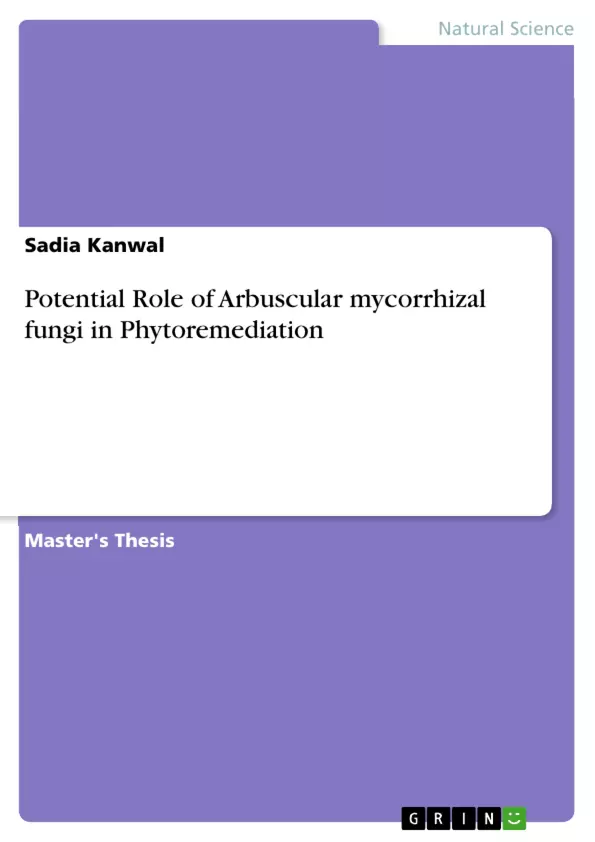The increase of metals pollution in soil is a worldwide problem that effects the health of humans and environment. The use of green technology such as phytoremediation is one the environmental friendly technique, in which plants and other microbes are used to reduce the level of metals contaminants in soil and lower its uptake towards plants tissues.
Studies reported a number of cereal crops such as wheat and medicinal plants like alfalfa accumulate heavy metals in their tissues at higher concentrations. In the present study, we investigated the effect of arbuscular mycorrhizal fungi (AMF) on wheat and alfalfa plants with the increase of zinc (Zn) and cadmium (Cd) concentrations in soil. After eight weeks of pot experiment, roots colonization, shoot and root biomass, growth, heavy metals contents and other biochemical parameters were assessed.
The results indicated mycorrhizal inoculated (M) plants performed better at moderate Zn and Cd concentrations. In addition, higher phosphorus contents were observed in M treated plants as compared to NM plants. Results indicated that AMF inoculum exhibit different tolerance strategies to reduce metals toxicity in host plants. The effective mycorrhizal symbiosis was observed with wheat and alfalfa plants and can be useful for phytostabilization of metals contaminated soils which can play a vital role in increase of plants productivity and safety.
Inhaltsverzeichnis (Table of Contents)
- LIST OF Abbreviations
- Chapter 1: Introduction
- 1.1: Phytoremediation
- 1.2: Heavy Metal Contamination
- 1.3: Arbuscular Mycorrhizal Fungi
- 1.4: Role of AMF in Phytoremediation
- 1.5: Objectives of the Study
- Chapter 2: Materials and Methods
- 2.1: Plant Material
- 2.2: Soil Collection and Preparation
- 2.3: AMF Inoculation
- 2.4: Heavy Metal Treatment
- 2.5: Growth Parameters
- 2.6: Biochemical Analysis
- 2.7: Statistical Analysis
- Chapter 3: Results and Discussion
- 3.1: Growth Parameters
- 3.2: Biochemical Analysis
- 3.3: Heavy Metal Accumulation
- Chapter 4: Conclusion
Zielsetzung und Themenschwerpunkte (Objectives and Key Themes)
This research investigates the potential of arbuscular mycorrhizal fungi (AMF) to enhance phytoremediation of heavy metal contaminated soils. The study aims to assess the impact of AMF on plant growth, heavy metal accumulation, and antioxidant enzyme activities in plants grown in soils contaminated with various heavy metals.
- The role of AMF in promoting plant growth and nutrient uptake.
- The influence of AMF on heavy metal accumulation in plants.
- The impact of AMF on antioxidant enzyme activities in plants exposed to heavy metals.
- The potential of AMF to enhance phytoremediation of heavy metal contaminated soils.
Zusammenfassung der Kapitel (Chapter Summaries)
Chapter 1 provides a comprehensive overview of phytoremediation, heavy metal contamination, and the role of arbuscular mycorrhizal fungi (AMF) in enhancing plant growth and remediation. The chapter outlines the objectives of the study, which aim to investigate the potential of AMF in promoting phytoremediation of heavy metal contaminated soils.
Chapter 2 details the materials and methods used in the study. This includes information on the plant material, soil collection and preparation, AMF inoculation, heavy metal treatment, growth parameter measurements, biochemical analysis, and statistical analysis.
Chapter 3 presents the results and discussion of the study. This chapter focuses on the effects of AMF on plant growth, heavy metal accumulation, and antioxidant enzyme activities in plants grown in heavy metal contaminated soils.
Schlüsselwörter (Keywords)
The key terms and concepts explored in this research include arbuscular mycorrhizal fungi (AMF), phytoremediation, heavy metal contamination, plant growth, heavy metal accumulation, antioxidant enzymes, and soil remediation.
- Citar trabajo
- Sadia Kanwal (Autor), 2013, Potential Role of Arbuscular mycorrhizal fungi in Phytoremediation, Múnich, GRIN Verlag, https://www.grin.com/document/323551



